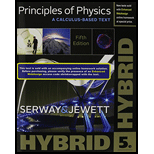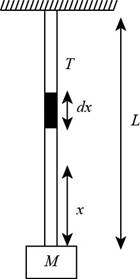
Concept explainers
(a)
To show: The time interval for a transverse pulse to travel the length of the rope is
(a)
Answer to Problem 62P
The time interval for a transverse pulse to travel the length of the rope is
Explanation of Solution
The free body diagram of the suspended object with rope is shown below.

Figure (1)
From free body diagram, the tension is equal to the weight of the body.
Here,
Formula to calculate the linear mass density is,
Here,
Formula to calculate the speed of the wave is,
Here,
Substitute
Formula to calculate the time taken to cover the smallest distance is,
Here,
Substitute
Integrate the right hand side of equation (3) from
Conclusion:
Therefore, the time interval for a transverse pulse to travel the length of the rope is
(b)
To show:The expression in part (a) reduces to the result of Problem 48 when
(b)
Answer to Problem 62P
the expression in part (a) reduces to the result of Problem 48 when
Explanation of Solution
The expression for the problem 48 is
The given expression in part (a) for total time is,
Substitute
Conclusion:
Therefore, the expression in part (a) reduces to the result of Problem 48 when
(c)
To show:The expression in part (a) reduces to
(c)
Answer to Problem 62P
The expression in part (a) reduces to
Explanation of Solution
The given expression in part (a) for total time is,
Apply the binomial theorem in the equation (5).
Conclusion:
Therefore, the expression in part (a) reduces to
Want to see more full solutions like this?
Chapter 13 Solutions
Principles of Physics: A Calculus-Based Text, Hybrid (with Enhanced WebAssign Printed Access Card)
- Mick and Rick are twins born on Earth in the year 2175. Rick grows up to be an Earth-bound robotics technician while Mick becomes an intergalactic astronaut. Mick leaves the Earth on his first space mission in the year 2200 and travels, according to his clock, for 10 years at a speed of 0.75c. Unfortunately, at this point in his journey, the structure of his ship undergoes mechanical breakdown and the ship explodes. How old is Rick when his brother dies?arrow_forwardHi, I have canceled, why did you charge me again?arrow_forwardNo chatgpt pls will upvotearrow_forward
 Physics for Scientists and Engineers: Foundations...PhysicsISBN:9781133939146Author:Katz, Debora M.Publisher:Cengage Learning
Physics for Scientists and Engineers: Foundations...PhysicsISBN:9781133939146Author:Katz, Debora M.Publisher:Cengage Learning Principles of Physics: A Calculus-Based TextPhysicsISBN:9781133104261Author:Raymond A. Serway, John W. JewettPublisher:Cengage Learning
Principles of Physics: A Calculus-Based TextPhysicsISBN:9781133104261Author:Raymond A. Serway, John W. JewettPublisher:Cengage Learning University Physics Volume 1PhysicsISBN:9781938168277Author:William Moebs, Samuel J. Ling, Jeff SannyPublisher:OpenStax - Rice University
University Physics Volume 1PhysicsISBN:9781938168277Author:William Moebs, Samuel J. Ling, Jeff SannyPublisher:OpenStax - Rice University Physics for Scientists and Engineers, Technology ...PhysicsISBN:9781305116399Author:Raymond A. Serway, John W. JewettPublisher:Cengage Learning
Physics for Scientists and Engineers, Technology ...PhysicsISBN:9781305116399Author:Raymond A. Serway, John W. JewettPublisher:Cengage Learning Physics for Scientists and Engineers with Modern ...PhysicsISBN:9781337553292Author:Raymond A. Serway, John W. JewettPublisher:Cengage Learning
Physics for Scientists and Engineers with Modern ...PhysicsISBN:9781337553292Author:Raymond A. Serway, John W. JewettPublisher:Cengage Learning Glencoe Physics: Principles and Problems, Student...PhysicsISBN:9780078807213Author:Paul W. ZitzewitzPublisher:Glencoe/McGraw-Hill
Glencoe Physics: Principles and Problems, Student...PhysicsISBN:9780078807213Author:Paul W. ZitzewitzPublisher:Glencoe/McGraw-Hill





